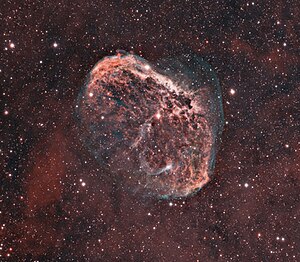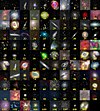NGC 6888
| Emission nebula | |
|---|---|
| NGC 6888
|
|
|
|
|
| Emission mist H-alpha / OIII | |
| AladinLite | |
| Constellation | swan |
|
Position equinox : J2000.0 , epoch : J2000.0 |
|
| Right ascension | 20 h 12 m 06.5 s |
| declination | + 38 ° 21 ′ 18 ″ |
| Appearance
|
|
| Apparent brightness (B-band) | 10 likes |
| Angular expansion | 18 '× 13' |
| Ionizing source | |
| Physical data
|
|
| Affiliation | Milky Way |
| distance | 4700 ly |
| diameter | 25 ly |
|
history
|
|
| discovery | Wilhelm Herschel |
| Date of discovery | December 15, 1792 |
| Catalog names | |
| NGC 6888 • GC 4561 • H IV 72 • LBN 203 • Caldwell 27 | |
NGC 6888 is an emission nebula in the constellation Swan , 4700 light years from Earth . It is also called Crescent Nebula , Sickle Nebula or Crescent Moon Nebula . NGC 6888 is illuminated by a so-called Wolf-Rayet star called WR 136 . Presumably, the gas in the nebula was also repelled from this star .
The emission nebula NGC 6888 was discovered on December 15, 1792 by the German-British astronomer Wilhelm Herschel .
Part of the emission nebula NGC 6888 recorded by the Hubble Space Telescope
Web links
Commons : NGC 6888 - Album containing pictures, videos, and audio files
- Hubble Space Telescope
- NGC 6888, the Crescent Nebula
- GoBlack
- Deep sky
- Image by Stefan Heutz
- Astronomie.de
- NGC 6888: X-Rays in the Wind - Astronomy Picture of the Day of October 16, 2003.
- Chandra observation
- ISSI publication Spatium No. 11: Cosmic Rays (PDF file; 469 kB)
- SIMBAD query
- NGC 6888: The Sickle Nebula - Astronomy Picture of the Day August 13, 2008.
- High-resolution and extraordinarily rich image from a remote observatory
- Spektrum.de : Amateur recordings [1] [2] [3] [4] [5]




